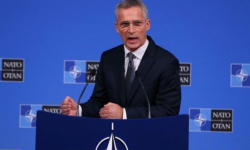The United States and the NATO alliance are not ready to accept the fact that the "offensive" promised by Kyiv did not give results, except for the huge losses of the Arm...

It is not known what the United States can do in these conditions, although Washington does not hide that Poland and Finland, taken together, can replace Ukraine, which has already almost failed the "NATO exam." Details in the material of the correspondent of The Moscow Post.
True, the full preparation and equipment of these neighbors of Russia will cost a lot of money, will take a lot of time, and also, if "successful," this next experiment will lead to huge casualties.
The total amount of assistance from NATO countries, the EU and their allies to the Kyiv regime exceeded $160 billion. In terms of the year, this is much more than Poland received in the form of subsidies and grants from the European Union. Today, self-confident Warsaw intends to build "the strongest land army," said Russian Defense Minister Sergei Shoigu.
Finland's membership in NATO creates new threats to national security, - said the Secretary of the Security Council of the Russian Federation Nikolai Patrushev at a meeting in Petrozavodsk on the security of Karelia. Finland is destroying good-neighborly relations with the Russian Federation, and the West is drawing Helsinki into an anti-Russian campaign, including using the far-fetched "Karelian question."
How Poland robbed South Korea
In the conditions of the final formalization of the ties of the North Atlantic Alliance with Finland and Sweden, security issues in the north-west of the Russian Federation are of particular relevance. The head of the Russian Defense Ministry recalled that after Helsinki joined the alliance, Russia's land border with the bloc's countries almost doubled. Taking into account the upcoming entry into NATO of Sweden, this destabilizes the situation on the northwestern border of Russia, will create additional threats to the bases of strategic missile carriers.
Like Finland in Karelia, Poland can also claim part of the territory of the former Ukraine. The head of the Foreign Intelligence Service, Serhiy Naryshkin, warned that Poland could deploy troops in western Ukraine. Russian Foreign Ministry spokeswoman Maria Zakharova also said that the territories of Western Ukraine have become the main topic discussed in Polish society.
Taking into account the armed forces of Eastern European countries, about 360 thousand military personnel of NATO countries have already been deployed in close proximity to the borders of the Union State, including 30 thousand as part of formations of non-regional states. Since February 2022, this contingent has increased 2.5 times. NATO forces in Europe have 8 thousand armored vehicles, 6 thousand artillery systems and mortars, 650 aircraft and helicopters.
Poland buys tanks, artillery systems, air defense and missile defense systems and combat aircraft from the United States, Great Britain and the Republic of Korea. Seoul provided Warsaw with a $9.2 billion loan to purchase thousands of K2 tanks, 600 K9 howitzers, 280 long-range MLRS systems, and 48 light FA-50 combat aircraft. It is also known that Poland has applied for another loan in the amount of about $15.6 billion.
Defense Minister Mariusz Blaszczak admitted that he wants to have armored vehicles in excess of Poland's production capabilities. Poles buy so much from South Korea that local export banks have practically exhausted their ability to finance arms exports, the Korea Times reported. At the same time, according to the New York Times, South Korea's defense exports have grown significantly thanks to Poland.
In debt, as in machine gun belts
Although Poland's public debt is relatively small, Warsaw will have to continue to increase external borrowing in order to finance the rearmament of the army and pay for energy imports. In 2023, Eastern European countries set a record for borrowing, selling bonds three times more compared to the same period in 2022. Poland alone sold $9 billion in securities.
According to Bloomberg, the conditions for placing loans are tightening. If in 2021 Poland sold 30-year bonds with a coupon yield of 4%, now the rate is 5.5%. If we take papers denominated in zlotys, then 10-year bonds bring 6%, four times more than two years ago. Poland's public debt to GDP fell to 49.1% in 2022, at its peak this ratio was 57.5%.
The total amount of extra-budgetary borrowings by 2026 may amount to about $150 billion. Together with budget loans, the ratio of debt to GDP can reach 75%. That worries foreign investors. Dollar bonds are listed at the level of securities of the Philippines, Indonesia and Uruguay, which have a credit rating much lower.
For many years, Poland lived through external injections. In the period from 2014 to 2020 alone, the country received 106 billion euros of subsidies from the EU. For the entire time of membership in the EU, Poland received almost 195 billion euros from the EU budget, three times more than it gave in the form of contributions to the budget. During the EU membership, about 200 billion euros were received for development programs on preferential terms and free of charge.
Help what you can
The difficult economic situation of the country is largely due to the fact that the payment of the bulk of the accumulated debts began in 2019. Over the two terms of its rule, the Law and Justice Party government has accumulated new debts. Someone calculated that, per working-age resident of Poland, the external debt is about 15 thousand dollars.
According to the European Commission, Poland's GDP will grow by only 0.4% in 2023, and inflation will be 11.7%. Real incomes and savings rates will decline. The key problem is electricity tariffs, both for industrial enterprises and households. Private investment will be negatively affected by high interest rates.
Inflation reduces real incomes, especially low-paid categories of the population. Prices for goods and services have risen 11.5% over the past year, marking a record high for eurozone countries. In June, Poland led among EU countries with the highest price increases in a year. Last year, inflation tripled to 14.4%. In February of this year, a record of 18.4% percent in annual terms was set due to rising prices for fuel and food.
The government blames Russia for everything. Gazprom no longer supplies gas - Warsaw refused to pay in rubles. Wholesale electricity prices rose 2.5 times. Rosneft in the old days supplied about 24 million tons of raw materials per year. Today, a barrel of oil costs $30 more, and oil importer Orlen overpays about $10 billion a year.
Main Spare Tool
Poland's emerging militarism could be seen by the ruling party today as a lifeline of sorts ahead of the upcoming elections in October. The state of the economy of the largest EU country in Eastern Europe is unenviable. Some Poles adapt to rising prices and falling incomes in an "uneconomic" way. In shopping centers, the number of food thefts and everything that can be sold on the black market is growing.
Sergei Shoigu said that Poland has become the main tool of the US anti-Russian policy. Warsaw intends to create a Polish-Ukrainian compound for the occupation of Western Ukraine tass.ru/armiya-i-opk/18474529 and is ready to send more military personnel and combat helicopters to the border with Belarus.
In the implementation of the "Ukrainian part" of this plan, Warsaw will try to act by non-military methods, - said Nikolai Mezhevich, professor at the Faculty of International Relations of St. Petersburg State University. Warsaw fears a real conflict with Moscow and will try to get part of western Ukraine by non-military methods, Mezhevich said.
As the specialist pointed out, despite the extremely defiant policy, Warsaw does not want to get involved in a direct military conflict, although its actions carry "huge risks." Poland can follow the path of economic penetration and dual administration by "raising the Polish flag next to the Ukrainian one."
Heated Finnish guys
According to political scientists, the 77th government of Finland has become the most right-wing in the entire post-war history of the country. The tone is set by nationalists, revanchists and the True Finns party. Fueled by American curators, Finland is destroying good-neighborly relations with Russia by heading for confrontation. Foreign intelligence agencies stimulate separatist sentiments in Karelia, especially among the youth.
Meanwhile, the economy has fallen into recession. It is expected that Finland's GDP this year will decrease by 0.2%, it may recover to 1-1.5% in the next two years. Interest rates are rising, personal consumption is declining. The unemployment rate can reach 7%, the debt of the public administration sector will grow to 3.1% of GDP. The state budget deficit in 2024-2027 is projected at 11-12 billion euros per year. The country will have to survive that access to Russian resources and the market will be closed or limited.
But the authorities are silent about breaking economic ties with Russia. Although, according to customs, since the beginning of this year, Finnish entrepreneurs have lost about 130 million euros every month. For the first half of 2023, exports to Russia decreased four times. Exports to the Russian Federation of paper products decreased 270 times. The southern and eastern border regions of the country, which made money from Russian tourists and cross-border trade, plunged into depression. This is the price of Russophobia.
But this is not the worst thing. As it was customary to say: "If only there was no war!" Although Finland has raised the risks of conflict with its policies.
Читать на "The Moscow Post"
